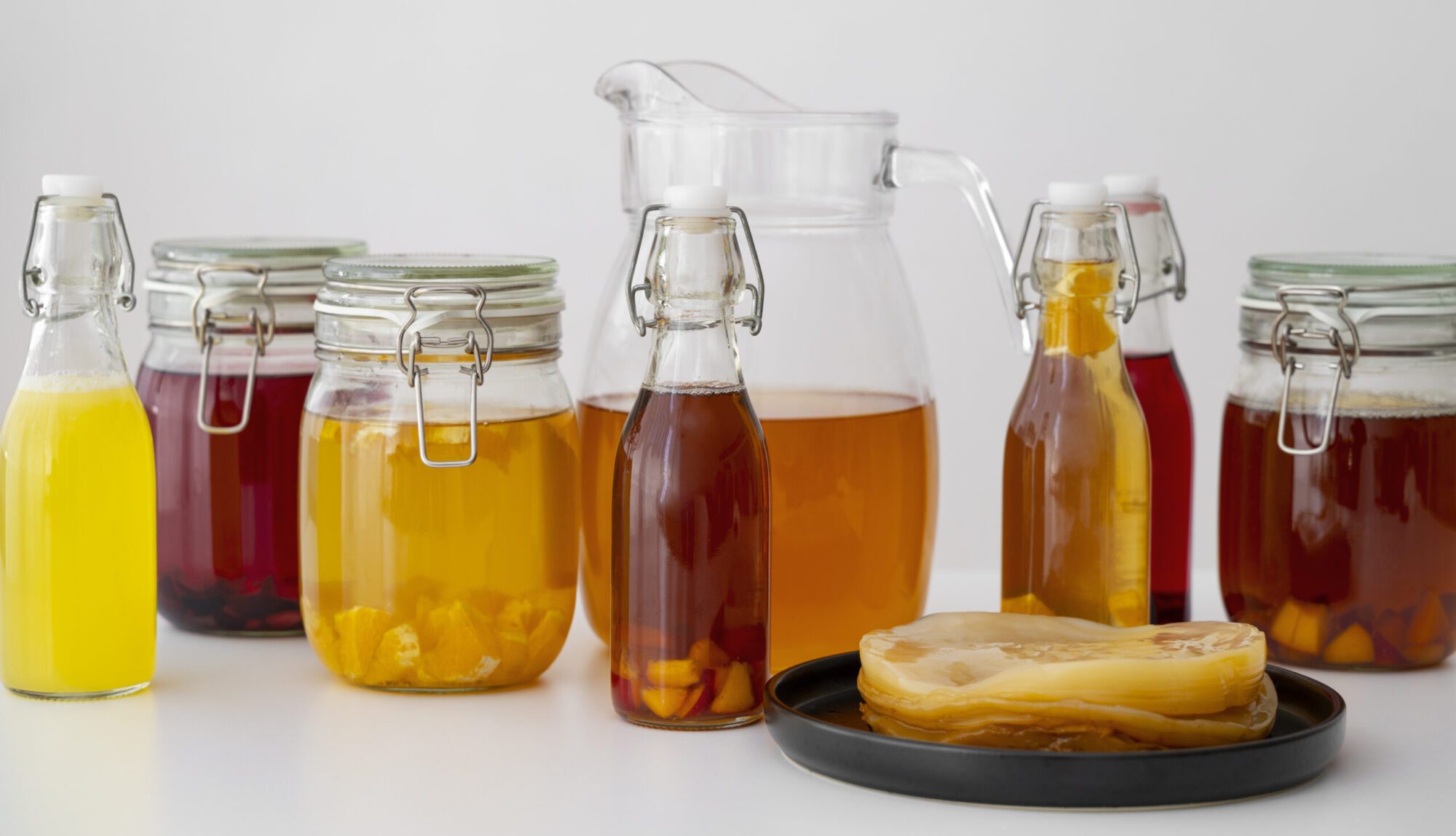Beginner’s Guide to Making Kombucha at Home

Beginner’s Guide to Making Kombucha at Home
If you’re a fan of kombucha, you’ll know that it’s an increasingly popular beverage that’s known for its tangy flavor, fizzy texture, and potential health benefits. But did you know that you can easily make your very own kombucha at home? Not only is it a fun and rewarding process, but it also gives you complete control over the ingredients and flavors, and can save you money in the long run. In this beginner’s guide, we’ll walk you through the steps of making your own delicious and healthy kombucha at home.
What is Kombucha?
First things first – what exactly is kombucha? Kombucha is a fermented tea beverage that has been consumed for thousands of years, with its origins dating back to ancient China. It’s made by fermenting sweetened tea with a symbiotic culture of bacteria and yeast, often referred to as a “SCOBY.” The fermentation process produces a slightly effervescent drink that’s packed with probiotics, antioxidants, and other beneficial compounds. Kombucha is often lauded for its potential health benefits, which may include improved digestion, strengthened immunity, and increased energy levels.
The basic ingredients for making kombucha include tea, sugar, water, and the SCOBY. You can also add additional flavorings and sweeteners during the secondary fermentation process to customize the taste of your kombucha. While the process of making kombucha can seem a bit daunting at first, it’s actually quite simple once you get the hang of it.
Getting started with making kombucha at home
Before you begin making your own kombucha, you’ll need to gather a few essential supplies. Here’s a list of what you’ll need:
– A large glass jar or brewing vessel (at least 1 gallon in size)
– A SCOBY (you can either purchase a SCOBY online or obtain one from a friend who already makes kombucha)
– Tea bags or loose leaf tea
– Sugar (typically white or cane sugar)
– Filtered water
– A breathable cover for the brewing vessel (such as a clean cloth or coffee filter)
– Bottles for bottling the finished kombucha
– Additional flavorings (optional)
Once you have all your supplies, you’re ready to start brewing your own kombucha!
Step 1: Prepare the sweetened tea
The first step in making kombucha is to prepare the sweetened tea base. Start by boiling water and steeping your tea bags or loose leaf tea in the hot water. Use about 4-6 tea bags or 2-3 tablespoons of loose leaf tea per gallon of water. Let the tea steep for about 10-15 minutes, then remove the tea bags or strain out the loose tea leaves.
Next, add sugar into the hot tea. The sugar is essential for feeding the SCOBY during the fermentation process, so don’t skimp on it. You’ll need about 1 cup of sugar per gallon of tea. Stir the sugar into the tea until it’s completely dissolved, then allow the sweetened tea to cool to room temperature.
Step 2: Add the SCOBY and starter liquid
Once the sweetened tea has cooled, transfer it to your brewing vessel. If you’re using a glass jar, make sure it’s clean and has been thoroughly washed and rinsed. Add the SCOBY to the sweetened tea, along with about 1-2 cups of starter liquid. The starter liquid is simply already brewed kombucha, and it helps to lower the pH of the tea to create an environment that’s suitable for the fermentation process.
Step 3: Ferment the kombucha
Cover the brewing vessel with a breathable cover, such as a clean cloth or coffee filter, and secure it with a rubber band. This will allow air to flow in and out of the vessel during fermentation while keeping out any contaminants.
Place the brewing vessel in a warm, dark place where it can ferment undisturbed. The ideal temperature for fermenting kombucha is between 75-85°F, so try to find a spot in your home that’s within this temperature range. Let the kombucha ferment for about 7-10 days, although the exact timing will depend on various factors such as the temperature of your home and your personal taste preferences. It’s a good idea to taste the kombucha after 7 days to see if it’s reached the desired level of tartness and fizziness.
Step 4: Bottle and flavor the kombucha
Once the kombucha has finished fermenting, it’s time to bottle and flavor it. Carefully remove the SCOBY from the brewing vessel and transfer it to a clean bowl. Set aside about 1-2 cups of the finished kombucha to use as starter liquid for your next batch, then pour the rest of the kombucha into bottles. You can add additional flavorings and sweeteners at this point to customize the taste of your kombucha. Some popular flavorings include fruit juices, herbs, and spices. Experiment with different combinations to find your favorite flavors!
Step 5: Carbonate the kombucha
After you’ve bottled the kombucha with your desired flavorings, let the bottles sit at room temperature for another 1-3 days to carbonate. This secondary fermentation process creates the fizzy texture that kombucha is known for. Keep a close eye on the bottles during this time to prevent them from becoming over-carbonated, which can cause them to explode. Burp the bottles by opening them briefly to release excess carbonation, and refrigerate the kombucha once it’s reached the desired level of fizziness.
And that’s it – you’ve successfully made your own kombucha at home! Once you’ve mastered the basic brewing process, you can start experimenting with different tea blends, flavors, and brewing techniques to create your own unique signature kombucha.
Tips for success
Here are a few additional tips to help you succeed in making kombucha at home:
– Use only glass, ceramic, or stainless steel containers for brewing and storing kombucha. Plastic and metal can react with the acidic nature of kombucha and potentially leach harmful chemicals into the beverage.
– Keep your brewing vessel and equipment clean and sanitized to prevent contamination with undesirable microorganisms.
– Be patient and trust the fermentation process. It may take a few batches to get a feel for how long to ferment your kombucha and how to achieve the desired level of tartness and fizziness.
– Store your finished kombucha in the refrigerator to slow down the fermentation process and maintain its flavor and carbonation.
Troubleshooting common issues
If you encounter any problems or challenges while making kombucha, don’t worry – it’s all part of the learning process. Here are a few common issues that you might run into and how to address them:
– Mold: If you see any signs of mold on the surface of your kombucha, it’s best to discard the entire batch and start fresh. Mold can ruin the entire fermentation process and make the kombucha unsafe to consume. To prevent mold, make sure your brewing vessel and equipment are clean, and always use enough starter liquid to lower the pH of the tea to a safe level.
– Fruit flies: During the fermentation process, fruit flies may be attracted to the sweet aroma of kombucha. To prevent them from getting into your brewing vessel, use a tight-fitting cloth or coffee filter to cover the vessel, and consider placing a small dish of apple cider vinegar with a few drops of dish soap next to the brewing vessel to attract and trap fruit flies.
– Foul odor or off flavors: If your finished kombucha has a strong or unpleasant odor, or if it tastes off, it may be due to contamination or an imbalance of yeast and bacteria in the SCOBY. Try using a different SCOBY or starter liquid, or make sure your brewing vessel and equipment are properly sanitized.
Once you’ve mastered the art of making kombucha at home, you can share your delicious creations with friends and family, and even experiment with creating unique flavor combinations and variations. Making kombucha at home is a fun and rewarding hobby that allows you to take control of what goes into your beverage and enjoy the health benefits of this ancient fermented drink. So why not give it a try and start brewing your own batch of kombucha today? Cheers to good health and delicious homemade kombucha!
[elementor-template id=”430″]
[elementor-template id=”433″]




0 Comments